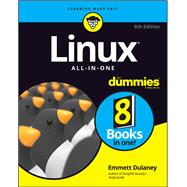8 mini books chock full of Linux!
Inside, over 800 pages of Linux topics are organized into eight task-oriented mini books that help you understand all aspects of the latest OS distributions of the most popular open-source operating system in use today. Topics include getting up and running with basics, desktops, networking, internet services, administration, security, scripting, Linux certification, and more.
This new edition of Linux All-in-One For Dummies has a unique focus on Ubuntu, while still including coverage of Debian, Red Hat, SuSE, and others. The market is looking for administrators, and part of the qualifications needed for job openings is the authentication of skills by vendor-neutral third parties (CompTIA/Linux Professional Institute)—and that’s something other books out there don’t address.
- Install and configure peripherals, software packages, and keep everything current
- Connect to the internet, set up a local area network (including a primer on TCP/IP, and managing a local area network using configuration tools and files)
- Browse the web securely and anonymously
- Get everything you need to pass your entry-level Linux certification exams
This book is for anyone getting familiar with the Linux OS, and those looking for test-prep content as they study for the level-1 Linux certification!








